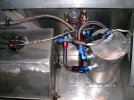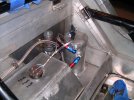Agreed that you should never mix/match hoses and hose ends.
I'm not a fan of Earls hose - it was junk a decade ago (although maybe has improved since then, but I'm an Aeroquip fanboy through and through since it's never failed me)
I've got Aeroquip starlite and stainless braid hoses that range from 3yrs to 20yrs old and all are in fantastic shape and you couldn't tell the difference between the 3yr old hose or the 20yr old hose (both flexible, no fuel weep smell, etc.)
I'm not saying they'll last forever, but if you have to change hose every 5-6yrs either it's garbage hose (not Aeroquip) or there's some serious alcohol content in your gas (I test mine for ethanol and avoid it like the plague, which definitely helps)
Btw, Aeroquip hose is AQP which, to my understanding, means it is considered non-aging, the same as PTFE, with life expectancy exceeding 20yrs. So I ~think~ that Aeroquip hose, both stainless and starlite, would last the same length of time as PTFE.


